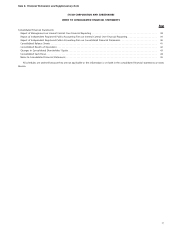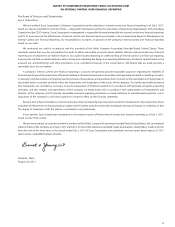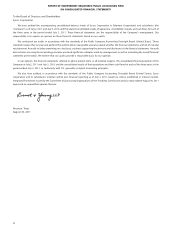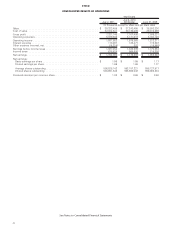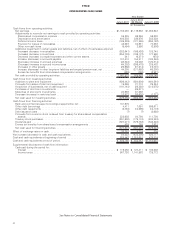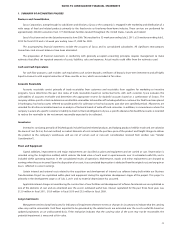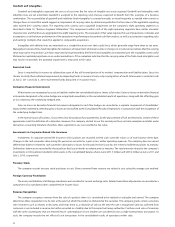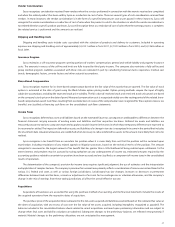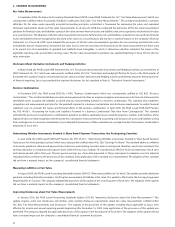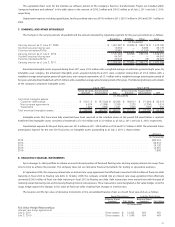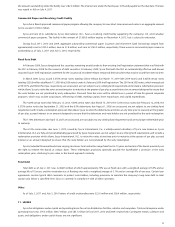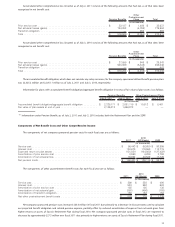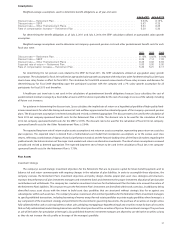Sysco 2011 Annual Report Download - page 71
Download and view the complete annual report
Please find page 71 of the 2011 Sysco annual report below. You can navigate through the pages in the report by either clicking on the pages listed below, or by using the keyword search tool below to find specific information within the annual report.Vendor Consideration
Sysco recognizes consideration received from vendors when the services performed in connection with the monies received are completed
and when the related product has been sold by Sysco as a reduction to cost of sales. There are several types of cash consideration received from
vendors. In many instances, the vendor consideration is in the form of a specified amount per case or per pound. In these instances, Sysco will
recognize the vendor consideration as a reduction of cost of sales when the product is sold. In the situations in which the vendor consideration is
not related directly to specific product purchases, Sysco will recognize these as a reduction of cost of sales when the earnings process is complete,
the related service is performed and the amounts are realized.
Shipping and Handling Costs
Shipping and handling costs include costs associated with the selection of products and delivery to customers. Included in operating
expenses are shipping and handling costs of approximately $2,222.1 million in fiscal 2011, $2,103.3 million in fiscal 2010, and $2,136.8 million in
fiscal 2009.
Insurance Program
Sysco maintains a self-insurance program covering portions of workers’ compensation, general and vehicle liability and property insurance
costs. The amounts in excess of the self-insured levels are fully insured by third party insurers. The company also maintains a fully self-insured
group medical program. Liabilities associated with these risks are estimated in part by considering historical claims experience, medical cost
trends, demographic factors, severity factors and other actuarial assumptions.
Share-Based Compensation
Sysco recognizes expense for its share-based compensation based on the fair value of the awards that are granted. The fair value of stock
options is estimated at the date of grant using the Black-Scholes option pricing model. Option pricing methods require the input of highly
subjective assumptions, including the expected stock price volatility. The fair value of restricted stock and restricted stock unit awards are based
on the company’s stock price on the date of grant. Measured compensation cost is recognized ratably over the vesting period of the related share-
based compensation award. Cash flows resulting from tax deductions in excess of the compensation cost recognized for those options (excess tax
benefits) are classified as financing cash flows on the consolidated cash flows statements.
Income Taxes
Sysco recognizes deferred tax assets and liabilities based on the estimated future tax consequences attributable to differences between the
financial statement carrying amounts of existing assets and liabilities and their respective tax bases. Deferred tax assets and liabilities are
measured pursuant to tax laws using rates expected to apply to taxable income in the years in which those temporary differences are expected to
be recovered or settled. The impact on deferred tax assets and liabilities of a change in tax rate is recognized in income in the period that includes
the enactment date. Valuation allowances are established when necessary to reduce deferred tax assets to the amount more likely than not to be
realized.
Sysco recognizes a tax benefit from an uncertain tax position when it is more likely than not that the position will be sustained upon
examination, including resolutions of any related appeals or litigation processes, based on the technical merits of the position. The amount
recognized is measured as the largest amount of tax benefit that has greater than a 50% likelihood of being realized upon settlement. To the
extent interest and penalties may be assessed by taxing authorities on any underpayment of income tax, estimated amounts required by the
accounting guidance related to uncertain tax positions have been accrued and are classified as a component of income taxes in the consolidated
results of operations.
The determination of the company’s provision for income taxes requires significant judgment, the use of estimates and the interpretation
and application of complex tax laws. The company’s provision for income taxes primarily reflects a combination of income earned and taxed in the
various U.S. federal and state, as well as various foreign jurisdictions. Jurisdictional tax law changes, increases or decreases in permanent
differences between book and tax items, accruals or adjustments of accruals for tax contingencies or valuation allowances, and the company’s
change in the mix of earnings from these taxing jurisdictions all affect the overall effective tax rate.
Acquisitions
Acquisitions of businesses are accounted for using the purchase method of accounting, and the financial statements include the results of
the acquired operations from the respective dates of acquisition.
The purchase price of the acquired entities is allocated to the net assets acquired and liabilities assumed based on the estimated fair value at
the dates of acquisition, with any excess of cost over the fair value of net assets acquired, including intangibles, recognized as goodwill. The
balances included in the consolidated balance sheets related to recent acquisitions are based upon preliminary information and are subject to
change when final asset and liability valuations are obtained. Subsequent changes to the preliminary balances are reflected retrospectively, if
material. Material changes to the preliminary allocations are not anticipated by management.
47


